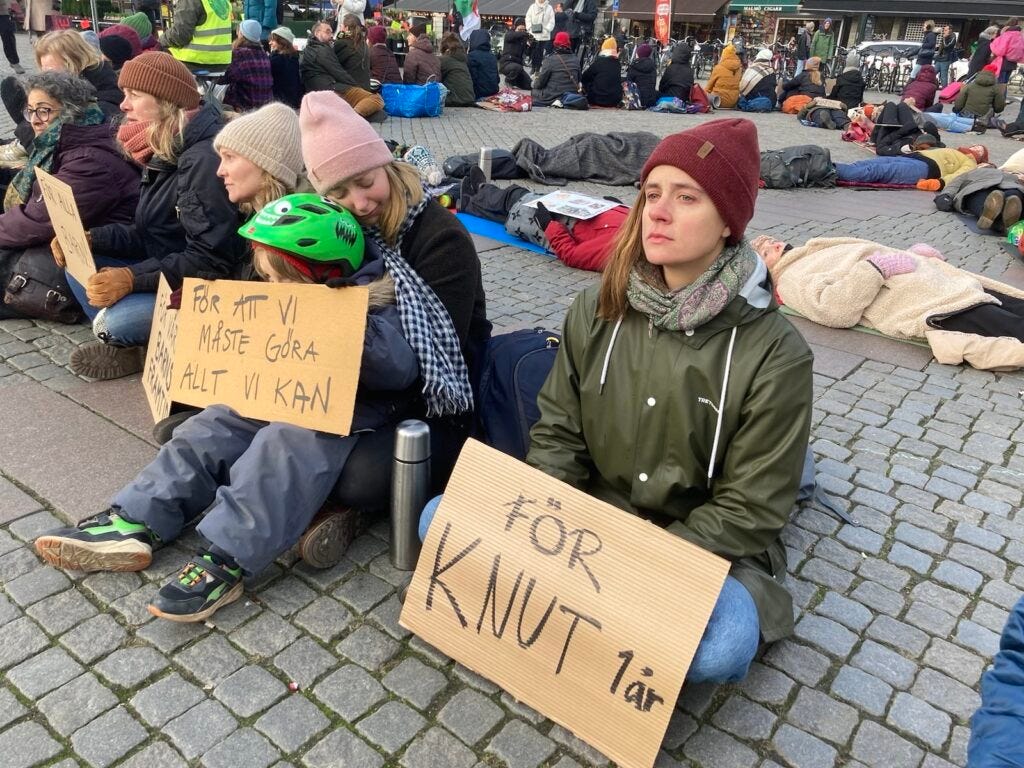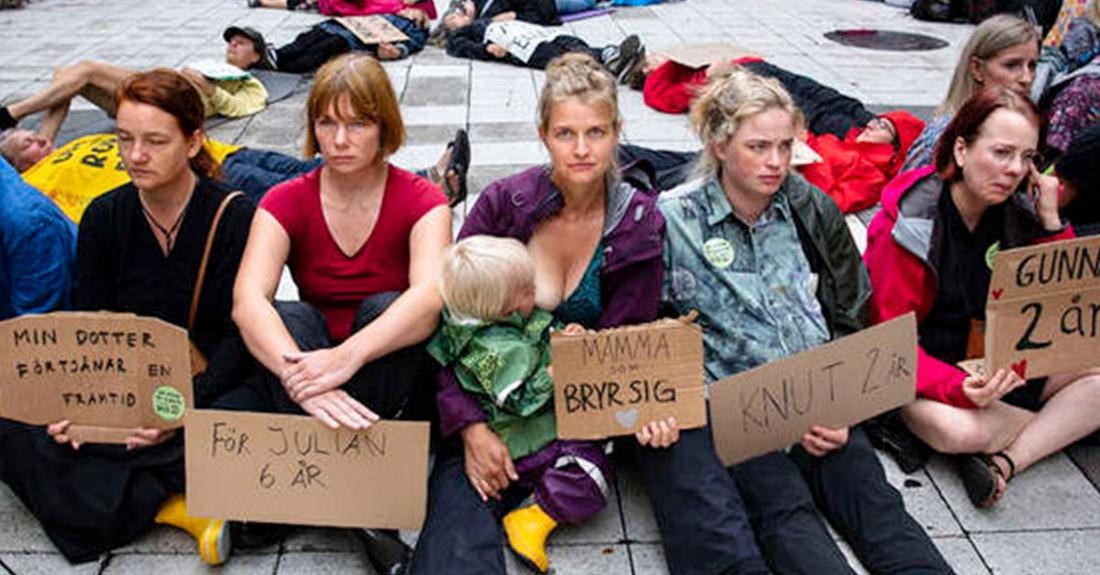Navigating the ecosystem of climate action.
Mothers' rebellion tactics of emotional disruption and the purpose it serves.
Welcome to Climate Psyched, and the eleventh edition of this newsletter where we explore all things psychology related to the climate and its parallel crises; how to create large-scale behavioral change, how to nurture psychological resilience, how to deal with climate delayers, and much more.
It’s been an emotional week in the Climate Psyched team. Working with climate issues, especially as psychologists, oftentimes requires us to hold space for others’ emotions, but also to be bearers of hope. As much as for everyone, our own climate related emotions oscillate back and forth, in a pattern similar to that researcher Panu Pihkala depicts in his research. Sometimes grief, anger, sadness and tiredness becomes more present and apparent.
This weekend, the first global manifestation by Mothers’ Rebellion brought it all closer to the surface.
Far from gaining the same type of attention as disruptive direct action, throwing soup at a Van Gogh painting or blocking roads, non-disruptive actions and manifestations do really have their place in the vast ecosystem of climate action.
Situation:
Last year a group of Swedish mothers, after having met over beers and shared frustration, decided to gather for a manifestation under the name Rebellmammorna (Mothers’ Rebellion). The first manifestation in Stockholm gathered around 70 mothers and allies, and during the fall the movement spread to several places across Sweden. During the spring, mobilization for a new manifestation saw the movement spread internationally and eventually gather mothers and allies from 19 countries in over 50 places on May 13th.
Part of, but independent from, Extinction Rebellion, Mothers Rebellion uses a tactic of sitting silently in a ring, facing outwards, holding signs with messages such as “For my child, 8 years old” or “Dear children, I will never stop fighting for your future”. Not disruptive in the usual sense, but emotionally disruptive. Many participants in the manifestations are taking their first steps in their climate engagement, encouraged by the support of others and the perceived non-danger of the calm, but emotional way of manifesting for climate action and justice.
The global Mothers Rebellion manifestation comes just weeks after Extinction Rebellion UK held its massive gathering, “The Big One” in London in April. Following a statement, at the beginning of the year, the UK group consciously decided to refrain from disruptive action, to instead mobilize a larger group of people. And they did: somewhere between 60 000 and 100 000 showed up, and manifested for climate action over several days. But in spite of the large number of participants, the gathering was hardly noted in mainstream media. Research on activism shows that it’s usually hard beforehand to know what actions will gain media attention, but that disruptive actions usually have a higher chance of breaching through the media noise.
Which brings us to the main question: are high risk, disruptive direct action the only ones worth carrying out?
Explanation:
In the enormous task of trying to slow down climate change, phase out emissions, restore biodiversity, save the soil, adapt to consequences of climate change and increase climate justice, there’s a multitude of things that we need to do. When we have a multitude of things on our collective to-do-list, it’s a good idea to investigate what our intended purpose of doing something is.
If you’ve been following Climate Psyched for a while you know that we’re proponents of enabling large-scale behavioral change that leads to system change. (We’ve written about that here, here and here.) Large-scale change is, however, not done by one political decision, or one magnificent disruptive action, but entails numerous behaviors and activities carried out over time in an intrinsic ecosystem of climate action.
Research on activism often highlights the so-called “Radical flank effect”, i.e. the tendency that when groups carry out radical, disruptive action, more moderate groups fighting for the same cause are perceived as more approachable for new participants. The radical flank lowers the threshold for other groups to mobilize a larger group of people. But the radical flank effect can only work if there’s actually something less radical next to it; a larger group that can mobilize and carry forward the need for bold climate action and justice. And in a wider perspective: the political decisions activists are striving to influence can only be decided if there are elected politicians voting on them.
The tendency to view activism in a hierarchical way, where we seek to find the one most effective climate action, and whisk away all others as meaningless, is colored by a patriarchal way of viewing the world and how we function in it. Only the toughest, most radical acts count. But this hierarchical way of viewing climate work neglects essential activities - and perhaps more importantly assumes that everything we do should serve the same purpose and that there’s an opposition between disruptive and non-disruptive action, between high impact action and other activities. This is incorrect.
Not everyone needs to, and not everything should serve the same purpose.
The emotionally disruptive tactics used by Mothers Rebellion speaks to other emotions than “usual” disruptive direct action (blocking a road or throwing paint at a fossil fuel company). Activists are often faced with the activist dilemma; doing things that upset people will gain attention, but you might be disliked, whereas doing things that don’t disrupt might make you more likable, but your actions probably will pass less noticeably by. But loud action isn’t the only way of getting through to people.
Where usual disruption often triggers people’s anger and discomfort, the silent circle used by Mothers’ Rebellion, where mothers and caretakers express their deepest concern and responsibility through their signs, seem to evoke something else. Grief, sadness, and a deep care for this world. It breaches through in another way and offers the potential of catching the attention of those who otherwise might choose to look away.
It’s still too early to say anything about Mothers Rebellion’s impact on climate policy and politics (actually, in activism research it’s always hard to say much about cause and effect of isolated manifestations). But outreach and impact aren’t the only valid purposes for a certain climate action. Dealing with the current, parallel crises is a marathon. Actually, it’s an ultra marathon. A practical, strategic and emotional ultra marathon. Everyone involved in it needs to find their own sustainability in order to last and endure that marathon.
Being able to connect to one’s emotions, whilst feeling the support of the group, being reminded that you share a deep concern, a deep love and a deep responsibility is not nothing. It’s on the contrary essential. The purpose of experiencing support whilst taking your first climate action steps, of allowing space for the grief and tiredness you might feel, seeing that you’re not alone in that experience will nurture much needed resilience and endurance.
From research on, and experience of, working with climate related emotions we know that there’s a crucial connection between taking action and regulating one’s emotions. Coping with climate emotions requires both. But different types of actions and activities give space for different types of emotions. Loud, strong action can evoke feelings of empowerment and functional anger. Slower, more silent collective action has on the other hand potential of giving space for emotions that generally are experienced as heavy and slowing; grief, sadness, but also a sense of belonging. Finding ways of connecting to this wide range of climate related emotions doesn’t in itself create high impact change, but it does something important: it makes us connected to the cause, to ourselves and our sense of meaning.
Action:
Climate and its connected crises, is sometimes called a super wicked problem. A problem that requires work in all sectors, using multiple competences and a wide palette of solutions.
We need a plethora of climate action. And while each and one of us should strategically consider where and how we best can put our time, competence and resources to practice (perhaps using our tool Impact Arrow), a too hierarchical way of viewing climate action poses the risk of neglecting the intrinsic ecosystem of action required to mitigate the climate crisis, adapt to its consequences and build up resilience. Practice viewing each climate action as part of a bigger ecosystem.
When doing something, choosing your tactics or strategy, remember to specify the intended purpose and goals. Only then can we evaluate whether we’re moving in the right direction.
Remember that this is an ultra marathon. Climate action that leads to burnout isn’t sustainable. Any group or organization needs to give space to cope with whatever emotions are tearing at us, as well as giving space for that which refills and restores us.
As always, we’d love to hear from you. Any thoughts or reflections are very welcome in the comment section. Or give us a like to let us know if you enjoyed this post, and share with those you think might be interested in reading.
See you all in June!



Tack för ett intressant resonemang. Jag tänker att rebellmammorna har en potential att kunna nå och locka betydligt fler att engagera sig då det är lågtysk-aktioner. Det som sen bruka ske är att lokalgrupper bildas och inom dessa tas nya initiativ till att försöka påverka. Så som en lågtröskel gemenskap för att hitta ett sammanhang att engagera sig i tänker jag att rebellmammorna fyller en viktig funktion, att mobilisera fler. Det känns så himla bråttom bara….tänk om denna rörelse kan växa och bli som Fridays for future var innan pandemin. Hoppas så. 💚🌏